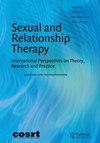撒旦教徒的性自我概念
IF 1.4
4区 心理学
Q3 PSYCHOLOGY, CLINICAL
引用次数: 1
摘要
摘要本研究在一个国际样本(n = 908)中调查了现代撒旦教徒的几种性行为和态度。提供了该样本的社会人口统计和宗教数据。撒旦教徒参与不同性行为的频率也被探讨。此外,我们还评估了撒旦教徒性自我概念的两个方面,即性自尊和性焦虑,以及这些变量与撒旦教徒群体认同的强度和被认定为撒旦教徒的时间长短的关系。结果表明,撒旦教徒的身份认同强度对他们的性自尊和性焦虑都有影响。讨论了撒旦崇拜与性的局限性和未来研究的方向。摘要:本研究的目的是调查现代撒旦教徒的性行为和性态度。研究人员调查了几种不同的性行为。此外,他们还评估了现代撒旦教徒看待自己性行为的方式。这项研究还旨在确定作为撒旦教徒的身份如何影响撒旦教徒如何看待自己的性取向。关键词:性自我概念撒旦主义性焦虑性自尊撒旦主义披露声明作者未报告潜在利益冲突。samuel Danielson是曼卡托明尼苏达州立大学临床心理学硕士课程的毕业生。他的研究兴趣包括宗教信仰和对性的态度,撒旦崇拜和强迫性性行为的影响。埃里克SprankleDr。Eric Sprankle是明尼苏达州立大学曼卡托分校的临床心理学教授,也是该校性研究项目的联合创始人和联合主任。他目前的研究重点是性、耻辱和撒旦崇拜的交叉点。本文章由计算机程序翻译,如有差异,请以英文原文为准。
Satanists’ sexual self-concept
AbstractThe present study examines several sexual behaviors and attitudes within an international sample (n = 908) of modern Satanists. Sociodemographic and religious data from this sample are provided. Frequencies of Satanists’ engagement in different sexual behaviors are also explored. Furthermore, two aspects of Satanists’ sexual self-concept, sexual self-esteem and sexual anxiety, are assessed along with these variables’ relationships with the strength of Satanists’ group identity and the length of time identifying as a Satanist. Results indicate that the strength of Satanists’ identity impacts both their sexual self-esteem and sexual anxiety. Limitations and directions for future research on Satanism and sexuality are discussed.LAY SUMMARYThe purpose of this study is to examine the sexual behaviors and attitudes of modern Satanists. Several different kinds of sexual behaviors were examined. Additionally, the way in which modern Satanists see themselves sexually was assessed. This study also aimed to determine how identifying as a Satanist impacts how Satanists see themselves sexually.Keywords: Sexual self-conceptSatanismsexual anxietysexual self-esteemSatanists Disclosure statementNo potential conflict of interest was reported by the author(s).Additional informationNotes on contributorsSamuel DanielsonSamuel Danielson is a graduate of the clinical psychology master’s program at Minnesota State University, Mankato. His research interests include the effects of religious beliefs and attitudes on sexuality, Satanism, and compulsive sexual behavior.Eric SprankleDr. Eric Sprankle is a Professor of Clinical Psychology at Minnesota State University, Mankato where he is also the co-founder and co-director of the Sexuality Studies program. His current research focuses on the intersections of sexuality, stigma, and Satanism.
求助全文
通过发布文献求助,成功后即可免费获取论文全文。
去求助
来源期刊

Sexual and Relationship Therapy
PSYCHOLOGY, CLINICAL-
CiteScore
3.80
自引率
9.10%
发文量
37
期刊介绍:
Sexual and Relationship Therapy is a leading independent journal in its field, well established and internationally recognized. It offers an active, multidisciplinary forum for review and debate across the spectrum of sexual and relationship dysfunctions and therapies. The journal presents original research and best practice and is a vehicle for new theory, methodology, and application. Sexual and Relationship Therapy is edited by a respected international team and publishes contributions from around the world. It is the official journal of the British Association for Sexual and Relationship Therapy (BASRT).
 求助内容:
求助内容: 应助结果提醒方式:
应助结果提醒方式:


